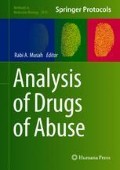Abstract
Analysis of drugs of abuse constitutes a major portion of work for many crime laboratories. The most important and most utilized technique for the screening and identification of solid-dosage drugs is gas chromatography–mass spectrometry (GC-MS). A detailed practical procedure is described for the rapid screening and identification by GC-MS of most drugs of abuse that are commonly encountered in forensic drug laboratories.
Access this chapter
Tax calculation will be finalised at checkout
Purchases are for personal use only
References
Audier H, Fetizon M, Ginsburg D, Mandelbaum A, Rull T (1965) Mass spectrometry of the morphine alkaloids. Tetrahedron Lett 6:13–22
Bellman SW (1968) Mass spectral identification of some hallucinogenic drugs. J AOAC Int 51:164–178
Nigam IC, Holmes JL (1969) Mass spectrometry of lysergic acid diethylamide. J Pharm Sci 58:506–507
Scientific Working Group for the Analysis of Seized Drugs (SWGDRUG) http://www.swgdrug.org/approved.htm. Last accessed 22 May 2017
ASTM E-2329 Practice for the identification of seized drugs. ASTM International, West Conshohocken, PA E-2729-17 (2017)
McLafferty FW, Stauffer DA, Loh SY, Wesdemiotis C (1999) Unknown identification using reference mass spectra. Quality evaluation of databases. J Am Soc Mass Spectrom 10:1229–1240
Adair AR, Noggle FT, Odom MS, Rhodes MA (1983) The ANOR (alternate non-aqueous organic ratio) extraction procedure. Micrograms XVI 1:220–228
Saloom JM (1983) Use of the ANOR method for separation of propoxyphene from propoxyphene + APC. Micrograms XVI 1:229–231
Author information
Authors and Affiliations
Corresponding author
Editor information
Editors and Affiliations
Rights and permissions
Copyright information
© 2018 Springer Science+Business Media, LLC, part of Springer Nature
About this protocol
Cite this protocol
Brettell, T.A., Lum, B.J. (2018). Analysis of Drugs of Abuse by Gas Chromatography–Mass Spectrometry (GC-MS). In: Musah, R. (eds) Analysis of Drugs of Abuse. Methods in Molecular Biology, vol 1810. Humana Press, New York, NY. https://doi.org/10.1007/978-1-4939-8579-1_3
Download citation
DOI: https://doi.org/10.1007/978-1-4939-8579-1_3
Published:
Publisher Name: Humana Press, New York, NY
Print ISBN: 978-1-4939-8578-4
Online ISBN: 978-1-4939-8579-1
eBook Packages: Springer Protocols

